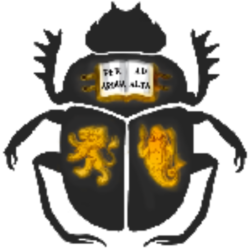On Monday 9th March I was invited to talk on ancient Egyptian music for the Wirral Ancient Egypt Society (WAES). This group, formed in 2001, began, like Birmingham Egyptology, for like-minded students to come together and share their research. They now hold monthly talks for eleven months of the year as well as various trips and museum visits. Of course, the University of Liverpool, the World Museum and the Garstang Museum have important links to Egyptology and hold significant Egyptological collections, although the Wirral itself has a very different history – WAES is based very close to Port Sunlight, the home of Sunlight soap produced by Lever Brothers, the latter of which formed part of Unilever. I had the pleasure of being shown Port Sunlight and the Lady Lever Art Gallery (which has a small number of Egyptian objects) by the WAES secretary Jacky Finch. Port Sunlight is very reminiscent of Birmingham’s Bournville in its purpose and feel – both were built to house those who worked in the nearby factory and to provide decent living conditions.
One of the Lever brothers, William Hesketh Lever, 1st viscount Leverhulme, built the Lady Lever Art Gallery and was not only a collector of art (mainly British) but also funded two of John Garstang’s Liverpool University excavations in Egypt and thus received some of the finds in return. Therefore, even though there appeared to be very little to link the Wirral to Egypt other than through its proximity to Liverpool, a little more digging reveals a greater connection, and it was a pleasure to learn more about it in my brief visit.
In my talk I covered the evidence for music and suggestions for the ways in which we can start to recreate it, my title ‘Words, gestures, strings and timbres’ providing the basis for these suggestions. Pete Stephens has written up a report which appears in their most recent newsletter. The relevant extract can be found here: WAES newsletter
I would like to thank WAES for inviting me to speak, for their very warm welcome and for the inquisitive audience with all their questions. I also managed to fit in a visit to the World Museum in Liverpool, where there is a small Egyptian harp on display, complete with pegs. The vast majority of ancient harps had fixed pegs onto which the strings were tied, unlike modern stringed instruments whose pegs can be turned to adjust the tension in the strings. Nevertheless, such features serve to underline the similarities between ancient and modern instruments and music, and it is those similarities which can help us attempt to reconstruct ancient music, particularly through ethnomusicological research.
Information about WAES can be found on the website, www.waes.org.uk.

